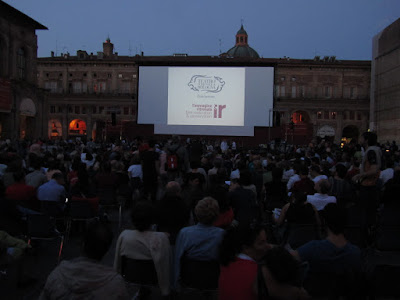Each summer in Bologna at the end of June there is a film festival featuring movies that have been ritrovato (recovered or rediscovered). These may be old motion pictures from the late 19th or early 20th century that are truly new-found, or they might be commercial movies up to the 1970s, but they have all been restored frame by frame to allow audiences to discover their best qualities. They are shown in their original language with Italian and English subtitles (sottotitoli) if necessary. (In Italy, commercial films are almost always dubbed into Italian rather than shown with subtitles, so seeing them with the original language is unusual.) There is generally a featured director (Howard Hawks this year) as well as a featured Italian film maker along with lots of silent films accompanied by live, internationally known musicians. There are hundreds of films and symposia over the course of about a week. For more info about this film festival, click here.
Most of the films are screened at three indoor cinemas throughout the day and evening, but the fun place to watch is sotto le stelle (under the stars) in the huge Piazza Maggiore in front of the Basilica of San Petronio.
 |
| 1800 chairs in Piazza Maggiore |
 |
| The projection booth |
They have set up an enormous screen at one end (known as a maxischermo) and a professional projection booth at the other. In between are about 1800 chairs, most of which are available for free. For popular films the seating fills by 9:30 and the overflow crowd camps out on the steps of the basilica, at cafe tables and in much of the remaining open space. The program starts at 10 p.m. (You'll notice perhaps that the front of the Basilica di S. Petronio is undergoing restoration and is enveloped in a full-size graphic reproduction of the façade beneath. This technique is common in Italy to help minimize the impact of restauro on large edifices.)
 |
| Just before show time, a slide show of the sponsors. |
Last Tuesday night we watched Gentlemen Prefer Blondes in the piazza, a Howard Hawks musical from 1953 starring Marilyn Monroe and Jane Russell, and it was great. The film has been restored to perfection, and the projected images were bright and clear, with colors not over-saturated like some restorations I’ve seen. The movie is very engaging, but occasionally I found myself thinking about the strange confluence of 1950s American exuberance (Jane Russell singing “Anyone Here For Love?” while roaming among the U.S. men’s Olympic team, who are exercising in flesh-colored swim trunks aboard an ocean liner bound for France!) and a crowd of about 3000 watching it with Italian subtitles on a warm summer night in the centro storico of Bologna.
 |
| Jane Russell and the Olympic team... |
Before the feature film on Tuesday they showed two silent films, one French from 1914 showing 6 minutes of views of the Thames near Oxford and Windsor that were so beautifully shot that they could have been done last week—except for the 100-year-old canal locks and boats—and it was in partial color with under-saturated green trees and brown buildings. The other silent was a 9-minute Italian comedy from 1911. Both were accompanied by a single fisarmonica (accordion) played live on the stage in front of the big screen and amplified just right for all to hear.
Last night (Friday, July 1st) the feature in the piazza was the silent version of Phantom of the Opera from 1925, starring Lon Chaney, accompanied by a full orchestra from the Teatro Comunale, including an organ for the critical scenes in the Phantom’s elaborate refuge. And there was a soprano soloist (Gerda Findeisen) to voice the heroine during scenes in the Paris Opera. The score was written in 1990 and directed last night by the composer, Gabriel Thibaudeau, and beautifully matched the action on screen.
 |
| The Phantom carries Christine down to the 5th sub-basement. The orchestra's music stand lights are below. |
 |
| A still shot with the Phantom unmasked in his lair. |
As you might guess from the foregoing, this print was the definitive version, complete with tinted film stock—reddish in the subterranean catacombs, blueish in the shadowy backstage, an eerie green in the Phantom’s lair—and a short color section during a party in the opera house. The color scenes culminate with the Phantom dressed as The Red Death clinging to an enormous statue atop the opera house at night, with his huge red cape billowing in the wind, as our heroine and her lover plan their escape in the shadows below, unaware of his presence. It’s an amazing piece of cinema.
 |
| Color party scene in the Paris Opera |
 |
| 1925 Poster |
The audiences for these performances were a mix of ages, nationalities and presumably education and experience, but they were remarkably attentive and polite. The most amazing thing is that I never heard a cellphone ring—this in a crowd of thousands in a city where every third person walking down the strada is talking on a telefonino!
Roberto

Now we know how to keep Italians quiet.
ReplyDelete